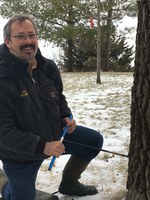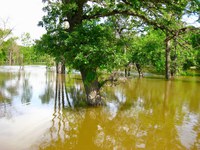NDSU and UMN Researchers to Unearth Old Red River Flood Evidence
(Click an image below to view a high-resolution image that can be downloaded)
Researchers at North Dakota State University and the University of Minnesota are using a grant from the National Science Foundation to search for evidence of floods along the Red River of the North through trees.
Joe Zeleznik, NDSU Extension forester, and Scott St. George, assistant professor of geography at the University of Minnesota, were awarded a $349,934 grant for their research titled “Paleohydrological Assessment of Extreme Flooding Events.”
“During the past two decades, Red River floods have caused more than $3.5 billion in direct damages to communities in North Dakota and Minnesota,” Zeleznik says. “But because the known record of Red River floods only extends back to the late 19th century, other sources of information are needed to estimate the risks of future severe floods.”
Zeleznik and St. George will look for evidence of older floods in the rings of bur oak trees growing along the river. Downstream in Manitoba, similar tree-ring evidence has been used to extend the local record of Red River floods back to the middle of the 17th century.
“One hundred or so years is not long enough to take the measure of a river like the Red,” St. George says. “This award will help communities like Fargo and Grand Forks better evaluate the risk of future floods.”
On the Canadian side, the record flood occurred in 1826, decades before river observations were available along the American stretch of the river. The research Zeleznik and St. George conducts will determine whether the river produced an extreme flood in the same year upstream in the U.S.
The research team, including master’s degree and undergraduate students and volunteers, will collect samples from old oak trees in the basin, recover timbers from historic buildings and drag buried oak logs out of the river’s banks.
“Bur oaks in the Red River basin can live more than 400 years, so their rings are a wonderful source of truly long-term information,” Zeleznik says.
The project will help determine if extreme floods on the river are becoming more common due to natural or human-related factors.
The team will attend the January 2019 meeting of the Red River Basin Commission in Grand Forks, N.D., and are excited to meet landowners who are able to share information about old oak trees or historic buildings built from local oaks.
NDSU Agriculture Communication - Dec. 7, 2018
| Source: | Joe Zeleznik, 701-231-8143, joseph.zeleznik@ndsu.edu |
|---|---|
| Source: | Scott St. George, 612-625-6080, stgeorge@umn.edu |
| Editor: | Ellen Crawford, 701-231-5391, ellen.crawford@ndsu.edu |



